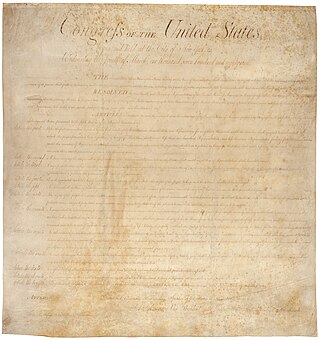Related Research Articles

The Constitution of the United States is the supreme law of the United States of America. It superseded the Articles of Confederation, the nation's first constitution, in 1789. Originally comprising seven articles, it delineates the national frame and constraints of government. The Constitution's first three articles embody the doctrine of the separation of powers, whereby the federal government is divided into three branches: the legislative, consisting of the bicameral Congress ; the executive, consisting of the president and subordinate officers ; and the judicial, consisting of the Supreme Court and other federal courts. Article IV, Article V, and Article VI embody concepts of federalism, describing the rights and responsibilities of state governments, the states in relationship to the federal government, and the shared process of constitutional amendment. Article VII establishes the procedure subsequently used by the 13 states to ratify it. The Constitution of the United States is the oldest and longest-standing written and codified national constitution in force in the world today.

The Second Amendment to the United States Constitution protects the right to keep and bear arms. It was ratified on December 15, 1791, along with nine other articles of the Bill of Rights. In District of Columbia v. Heller (2008), the Supreme Court affirmed for the first time that the right belongs to individuals, for self-defense in the home, while also including, as dicta, that the right is not unlimited and does not preclude the existence of certain long-standing prohibitions such as those forbidding "the possession of firearms by felons and the mentally ill" or restrictions on "the carrying of dangerous and unusual weapons". In McDonald v. City of Chicago (2010) the Supreme Court ruled that state and local governments are limited to the same extent as the federal government from infringing upon this right. New York State Rifle & Pistol Association, Inc. v. Bruen (2022) assured the right to carry weapons in public spaces with reasonable exceptions.

The Seventh Amendment to the United States Constitution is part of the Bill of Rights. This amendment codifies the right to a jury trial in certain civil cases and inhibits courts from overturning a jury's findings of fact.
In American political discourse, states' rights are political powers held for the state governments rather than the federal government according to the United States Constitution, reflecting especially the enumerated powers of Congress and the Tenth Amendment. The enumerated powers that are listed in the Constitution include exclusive federal powers, as well as concurrent powers that are shared with the states, and all of those powers are contrasted with the reserved powers—also called states' rights—that only the states possess.
United States v. Cruikshank, 92 U.S. 542 (1876), was a major decision of the United States Supreme Court ruling that the U.S. Bill of Rights did not limit the power of private actors or state governments despite the adoption of the Fourteenth Amendment. It reversed the federal criminal convictions for the civil rights violations committed in aid of anti-Reconstruction murders. Decided during the Reconstruction Era, the case represented a major defeat for federal efforts to protect the civil rights of African Americans.

Gun politics is defined in the United States by two primary opposing ideologies concerning the private ownership of firearms. Those who advocate for gun control support increasingly restrictive regulation of gun ownership; those who advocate for gun rights oppose increased restriction, or support the liberalization of gun ownership. These groups typically disagree on the interpretation of the text, history and tradition of the laws and judicial opinions concerning gun ownership in the United States and the meaning of the Second Amendment to the Constitution of the United States. American gun politics involves these groups' further disagreement concerning the role of firearms in public safety, the studied effects of ownership of firearms on public health and safety, and the role of guns in national and state crime.
United States v. Miller, 307 U.S. 174 (1939), was a landmark decision of the Supreme Court of the United States that involved a Second Amendment to the United States Constitution challenge to the National Firearms Act of 1934 (NFA). The case is often cited in the ongoing American gun politics debate, as both sides claim that it supports their position.
In United States constitutional law, incorporation is the doctrine by which portions of the Bill of Rights have been made applicable to the states. When the Bill of Rights was ratified, the courts held that its protections extended only to the actions of the federal government and that the Bill of Rights did not place limitations on the authority of the state and local governments. However, the post–Civil War era, beginning in 1865 with the Thirteenth Amendment, which declared the abolition of slavery, gave rise to the incorporation of other amendments, applying more rights to the states and people over time. Gradually, various portions of the Bill of Rights have been held to be applicable to state and local governments by incorporation via the Due Process Clause of the Fourteenth Amendment of 1868.

The Second Amendment Foundation (SAF) is a United States nonprofit organization that supports gun rights. Founded in 1974 by Alan Gottlieb and headquartered in Bellevue, Washington, SAF publishes gun rights magazines and public education materials, funds conferences, provides media contacts, and has assumed a central role in sponsoring lawsuits.

In the United States, open carry refers to the practice of visibly carrying a firearm in public places, as distinguished from concealed carry, where firearms cannot be seen by the casual observer. To "carry" in this context indicates that the firearm is kept readily accessible on the person, within a holster or attached to a sling. Carrying a firearm directly in the hands, particularly in a firing position or combat stance, is known as "brandishing" and may constitute a serious crime, but is not the mode of "carrying" discussed in this article.

In Search of the Second Amendment is a documentary film on the Second Amendment of the United States Constitution. It was produced and directed by American author and attorney David T. Hardy. He argues the individual rights model of the Second Amendment. Hardy also discusses the Fourteenth Amendment.

The United States Bill of Rights comprises the first ten amendments to the United States Constitution. Proposed following the often bitter 1787–88 debate over the ratification of the Constitution and written to address the objections raised by Anti-Federalists, the Bill of Rights amendments add to the Constitution specific guarantees of personal freedoms and rights, clear limitations on the government's power in judicial and other proceedings, and explicit declarations that all powers not specifically granted to the federal government by the Constitution are reserved to the states or the people. The concepts codified in these amendments are built upon those in earlier documents, especially the Virginia Declaration of Rights (1776), as well as the Northwest Ordinance (1787), the English Bill of Rights (1689), and Magna Carta (1215).
In the United States, the right to keep and bear arms is modulated by a variety of state and federal statutes. These laws generally regulate the manufacture, trade, possession, transfer, record keeping, transport, and destruction of firearms, ammunition, and firearms accessories. They are enforced by state, local and the federal agencies which include the Bureau of Alcohol, Tobacco, Firearms and Explosives (ATF).
District of Columbia v. Heller, 554 U.S. 570 (2008), is a landmark decision of the Supreme Court of the United States. It ruled that the Second Amendment to the U.S. Constitution protects an individual's right to keep and bear arms—unconnected with service in a militia—for traditionally lawful purposes such as self-defense within the home, and that the District of Columbia's handgun ban and requirement that lawfully owned rifles and shotguns be kept "unloaded and disassembled or bound by a trigger lock" violated this guarantee. It also stated that the right to bear arms is not unlimited and that certain restrictions on guns and gun ownership were permissible. It was the first Supreme Court case to decide whether the Second Amendment protects an individual right to keep and bear arms for self-defense or whether the right was only intended for state militias.
McDonald v. City of Chicago, 561 U.S. 742 (2010), was a landmark decision of the Supreme Court of the United States that found that the right of an individual to "keep and bear arms", as protected under the Second Amendment, is incorporated by the Fourteenth Amendment and is thereby enforceable against the states. The decision cleared up the uncertainty left in the wake of District of Columbia v. Heller (2008) as to the scope of gun rights in regard to the states.
In the United States, right to keep and bear arms is a fundamental right protected by the Second Amendment to the United States Constitution, part of the Bill of Rights, and by the constitutions of most U.S. states. The Second Amendment declares:
A well regulated Militia, being necessary to the security of a free State, the right of the people to keep and bear Arms, shall not be infringed.

The history of concealed carry in the United States is the history of public opinion, policy, and law regarding the practice of carrying concealed firearms, especially handguns.
New York State Rifle & Pistol Association, Inc. v. Bruen, 597 U.S. ___ (2022), abbreviated NYSRPA v. Bruen and also known as NYSRPA II or Bruen to distinguish it from the 2020 case, is a landmark decision of the United States Supreme Court related to the Second Amendment to the United States Constitution. The case concerned the constitutionality of the 1911 Sullivan Act, a New York State law requiring applicants for a pistol concealed carry license to show "proper cause", or a special need distinguishable from that of the general public, in their application.
References
- ↑ "Second Amendment". cornell.edu. Archived from the original on September 11, 2017. Retrieved June 3, 2015.
- ↑ "Oklahoma Legislature Approves Second Amendment Day". Bearing Arms. Archived from the original on October 3, 2015. Retrieved June 3, 2015.
- ↑ "2022 Oklahoma Statutes" . Retrieved February 22, 2023.
- ↑ "Pennsylvania Second Amendment Action Day – May 12, 2015!". Prince Law Offices, P.C. April 14, 2015. Archived from the original on April 20, 2015. Retrieved June 3, 2015.
- ↑ "Lawmaker proposes gun rights education for South Carolina public schools (VIDEO)". Guns.com. Archived from the original on April 24, 2019. Retrieved April 23, 2019.